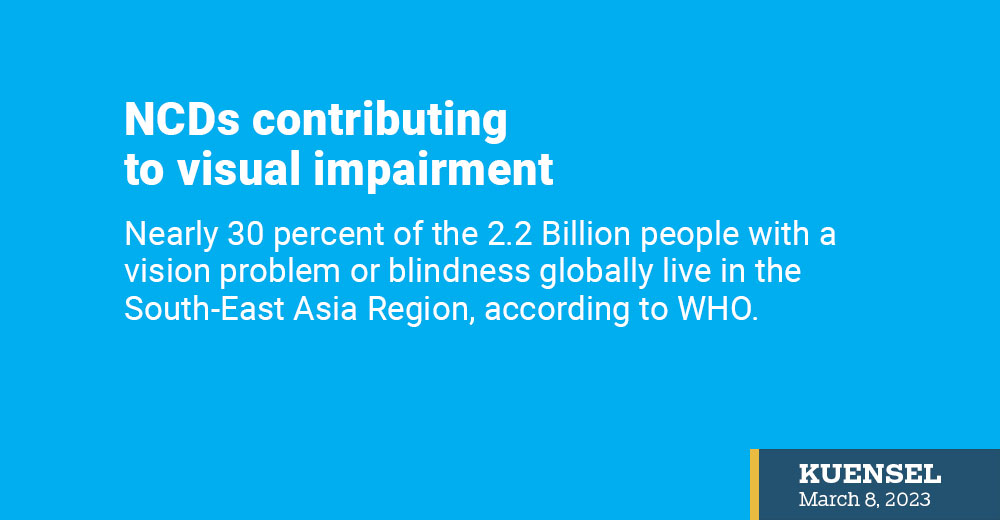Nima Wangdi
Nearly 30 percent of the 2.2 Billion people with a vision problem or blindness globally live in the South-East Asia Region, according to WHO.
WHO in India last month called for accelerated action to provide quality, affordable, integrated and people-centred comprehensive eye care for everyone to address the increasing burden of vision impairment and blindness in the South East Asia Region.
Regional Director Dr Poonam Khetrapal Singh during the high-level meeting of member countries on ‘Integrated People-Centred Eye Care’ said: “This huge burden is unacceptable, as nearly half the global vision impairment could have been prevented.”
She said that children and older people are most vulnerable but women in rural areas and ethnic minority groups are at greater risk.
She said that the increasing non-communicable diseases like diabetes are causing vision impairment and blindness.
The region is home to 87.6 million people with diabetes—30.6 million had diabetic retinopathy (eye disease caused by high blood sugar) and 9.6 million had sight-threatening retinopathy (blindness caused by untreated diabetic retinopathy), according to WHO.
Health ministers of member countries attended the three-day meeting and the programme managers from member countries of the region deliberated on urgent measures to roll out an “Action plan for integrated people-centred eye care in South-East Asia 2022 – 2030”.
The regional action plan aims at enabling countries to achieve 40 percent increase in effective coverage of refractive errors, 30 percent increase in effective coverage of cataract surgery, at least 80 percent of people with diabetes are screened regularly for retinopathy, and at least 80 percent of those identified with sight-threatening diabetic retinopathy are treated by 2030.
The plan also outlines measures that countries can take to eliminate trachoma in the Region by 2025. Two countries in the region—Nepal and Myanmar—have eliminated trachoma according to WHO.
“The regional action plan details a series of actionable, evidence-based and locally adaptable strategies which need to be implemented with urgency,” Dr Poonam Khetrapal Singh said.
She said the management of common eye health issues should be mainstreamed into routine health services and current care models must be reoriented to prioritise primary health care and community-based services.
Dr Poonam Khetrapal Singh also called for vigorously strengthening the eye health workforce and emphasised financial risk protection to enable people to access essential medicines, spectacles, low-vision aids, rehabilitation, and assistive products.
WHO will continue to provide full technical and operational support.
Officials from the health ministry said that Bhutan has holistic and integrated strategies.
Officials said that visual and hearing impairment are the two most common disabilities in the country. To address these, the ministry embarked on a comprehensive package of services in line with the government’s commitment to “narrow the gap” in service provision across the country in 2020.
“In our vision to eliminate avoidable blindness, Bhutan achieved 99.5 percent coverage of refractive error screening among school-going children and has provided free eyeglasses to children with refractive errors across the country,” an official said.


